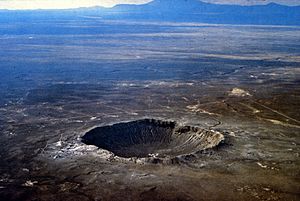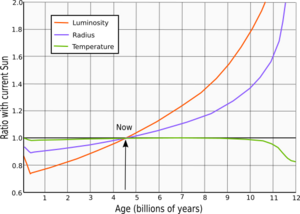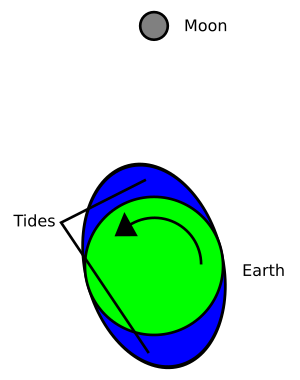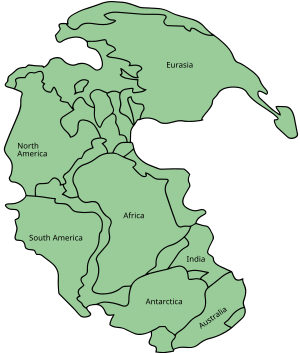Future of Earth facts for kids
The future of Earth is a fascinating topic! Scientists can guess what might happen to our planet by looking at how things work now. They study Earth's surface chemistry, how its inside is cooling, how other planets pull on it with gravity, and how the Sun is slowly getting brighter. One big unknown is how much human technology will change things. For example, humans are causing a mass extinction right now. This means many species are disappearing. But technology could also lead to humans disappearing, letting Earth return to its natural, slower changes.
Over millions of years, big space events could threaten life on Earth. These include comet or asteroid impacts. Also, a huge star explosion, called a supernova, could happen close to the Sun. Other big changes on Earth are more predictable. Milankovitch cycles tell us Earth will keep having ice ages. These are caused by small changes in Earth's orbit and tilt. Also, Earth's plate tectonics will likely form a new supercontinent in 250–350 million years. In 1.5–4.5 billion years, Earth's tilt might start wobbling wildly, changing by up to 90 degrees!
The Sun will keep getting brighter. This means more sunlight will hit Earth. This will speed up how rocks break down, which affects how much carbon dioxide (CO2) is in the air. In about 600 million years, CO2 levels will drop too low for many plants to survive. Some plants can live with less CO2, but eventually, all plant life will die out. When plants are gone, almost all animal life will also disappear because plants are the base of Earth's food chain.
In about one billion years, the Sun will be 10% brighter. This will turn Earth into a "moist greenhouse." The oceans will start to evaporate very quickly. This will likely stop plate tectonics and the entire carbon cycle. After this, in about 2–3 billion years, Earth's magnetic field might disappear. This would cause our atmosphere to slowly leak away. Four billion years from now, Earth's surface will get so hot that it will melt. This will be even hotter than Venus today. By then, all life on Earth will be gone. Finally, in about 7.5 billion years, the Sun will expand into a red giant star. It will likely swallow Earth whole.
Contents
Human Impact on Earth's Future
Humans play a huge role in Earth's living systems. Our large population affects many of Earth's ecosystems. This has led to the current Holocene extinction, where many species are disappearing. Since the 1950s, about 10% of all species have been lost. If this continues, about 30% of species could be gone in the next 100 years. This extinction is happening because of habitat destruction, the spread of new species to places they don't belong, poaching, and climate change. Humans have changed more than a third of Earth's land. We use about 20% of all the energy produced by plants. The amount of carbon dioxide in the air has gone up by almost 50% since the Industrial Revolution.

The effects of this species loss could last for at least five million years. There might be less variety of life, and many places could end up with similar types of plants and animals. Species that can adapt quickly, like pests and weeds, might become very common. New species might also appear, especially those that thrive in human-changed areas. Microbes (tiny living things) will likely do well in new environments with more nutrients. However, no new large animals are expected to appear. Also, food chains will probably become shorter.
There are many risks that could affect Earth globally. Some risks are caused by humans themselves. These include climate change, the misuse of tiny machines (nanotechnology), a nuclear holocaust (widespread nuclear war), wars with super-smart computers, diseases created by genetic engineering, or accidents from physics experiments. Natural events can also be dangerous. These include very strong diseases, asteroid or comet impacts, a runaway greenhouse effect, and running out of natural resources. It's hard to know how likely these events are to happen.
If humans were to disappear, the things we've built would slowly fall apart. The biggest structures might last about 1,000 years. The last things to survive would probably be huge mines, landfills, major roads, and large dams. Some massive stone monuments, like the pyramids or Mount Rushmore, might still be partly there after a million years.
Space Events That Could Affect Earth

As the Sun travels around the Milky Way galaxy, other stars might come close to our Solar System. A close star encounter could send many comets from the distant Oort cloud closer to the Sun. This could increase the number of comets hitting Earth by 40 times. Such impacts can cause mass extinctions. These close encounters happen about once every 45 million years. But the chance of the Sun actually crashing into another star is extremely low, about once every 30 trillion years. This is much longer than the age of the universe!
When an asteroid or comet about 5–10 kilometers (3–6 miles) wide hits Earth, it releases enough energy to cause a global disaster. One effect is a huge cloud of dust that blocks sunlight, making temperatures drop by about 15°C (27°F) in a week. This would stop photosynthesis for months, like a "nuclear winter." Big impacts like this happen about once every 100 million years. Over the last 540 million years, these impacts have likely caused five or six major extinctions and many smaller ones. This matches what scientists see in Earth's rock record. So, these events are expected to continue.
A supernova is a giant star explosion. In the Milky Way, supernovae happen about once every 40 years. Earth has likely seen many such explosions within 100 light-years. These "near-Earth supernovae" can send harmful radiation to our planet. Gamma rays from a supernova can damage Earth's ozone layer, which protects us from the Sun's harmful ultraviolet (UV) radiation. Even a small increase in UV radiation can hurt life, especially tiny ocean plants called phytoplankton that are at the bottom of the ocean food chain. A supernova 26 light-years away could cut the ozone layer in half. On average, a supernova happens within 32 light-years every few hundred million years, causing ozone loss for centuries. Over the next two billion years, about 20 supernovae and one gamma ray burst will likely affect Earth's life.
The gravity of other planets makes the inner Solar System behave a bit chaotically over very long times. This doesn't affect the Solar System's stability much over a few million years. But over billions of years, planet orbits become unpredictable. Computer models show a small chance (less than 1%) that Earth could crash into Mercury, Venus, or Mars in the next five billion years. There's also a tiny chance (1 in 100,000) that Earth could be thrown out of the Solar System by a passing star. If that happened, our oceans would freeze solid in millions of years. There's an even smaller chance (1 in 3 million) that Earth could be captured by another star system, allowing life to continue.
Earth's Orbit and Spin
The gravity of other planets changes Earth's orbit and how its spin axis is tilted. These changes can affect Earth's climate. But even with these interactions, detailed computer models show that Earth's orbit will likely stay stable for billions of years. Its distance from the Sun, its oval shape, and its tilt will stay mostly the same.
Ice Ages and Glaciation
Historically, Earth has had repeated ice ages where large ice sheets covered parts of the continents. These ice ages can happen because of changes in ocean currents and continent positions due to plate tectonics. The Milankovitch cycles explain that ice ages are caused by astronomical factors combined with climate feedback. The main space factors are a more oval orbit, a smaller tilt of Earth's axis, and the northern summer happening when Earth is farthest from the Sun. Each of these changes in cycles. For example, the orbit's oval shape changes over 100,000 and 400,000 years.
Earth is currently in an ice age called the Quaternary glaciation. We are in a warmer period within this ice age, called the Holocene interglacial period. This warm period would normally end in about 25,000 years. However, humans are releasing a lot of carbon dioxide into the air. This might delay the next ice age for at least 50,000–130,000 years. On the other hand, if we stop using fossil fuels by 2200, a short period of global warming would only affect the ice age for about 5,000 years. So, a brief period of warming from human pollution might not have a huge long-term impact.
Earth's Tilt and the Moon
The Moon's gravity slows Earth's spin and makes the Moon move farther away. Friction inside Earth and between the atmosphere and surface also slows Earth's spin. These effects are expected to make a day longer by more than 1.5 hours over the next 250 million years. Earth's tilt will also increase by about half a degree. The Moon will move about 1.5 Earth radii farther away during the same time.
Computer models show that the Moon helps keep Earth's tilt stable. This might prevent huge climate changes. The Moon does this by speeding up the wobble of Earth's spin axis. This avoids problems where the spin wobble matches the orbit wobble. But as the Moon moves farther away, its stabilizing effect will weaken. At some point, other gravitational pulls will likely cause Earth's tilt to change chaotically. The tilt could change by as much as 90 degrees! This is expected to happen between 1.5 and 4.5 billion years from now.
A large tilt would cause huge climate changes and might make Earth unable to support life. If Earth's tilt goes over 54 degrees, the equator would get less sunlight each year than the poles. Earth could stay tilted between 60 and 90 degrees for as long as 10 million years.
Earth's Changing Surface
Earth's surface is always changing due to plate tectonics. Mountains rise, volcanoes erupt, and erosion wears things down. Mount Vesuvius might erupt about 40 times in the next 1,000 years. During the same time, about five to seven earthquakes stronger than magnitude 8 could happen along the San Andreas Fault. About 50 earthquakes stronger than magnitude 9 might happen worldwide. Mauna Loa could erupt about 200 times in the next 1,000 years. The Niagara Falls will keep moving upstream, reaching Buffalo in about 30,000–50,000 years.
In 10,000 years, the Baltic Sea will become about 90 meters (300 feet) shallower as the land rises after the ice age. The Hudson Bay will also get 100 meters (330 feet) shallower. After 100,000 years, the island of Hawaii will have moved about 9 kilometers (5.6 miles) to the northwest. Earth might also be entering another ice age by then.
Continents on the Move
The theory of plate tectonics shows that Earth's continents are moving a few centimeters (about an inch) each year. This will continue, causing continents to move and crash into each other. Continental drift happens because of heat inside Earth and the presence of water. If either of these goes away, the continents will stop moving. Heat from radioactive materials inside Earth is enough to keep the mantle moving and plates sinking for at least another 1.1 billion years.
Right now, North and South America are moving west, away from Africa and Europe. Scientists have different ideas about how this will continue. Some think the Atlantic Ocean will shrink, and the Americas will reverse direction and move back towards Africa. Others think the Pacific Ocean will keep shrinking, and the Americas will move towards Asia.
As we learn more about Earth's movements, these ideas might change. In 2008, a computer model predicted that the way the mantle moves will change in the next 100 million years. This could create a new supercontinent made of Africa, Eurasia, Australia, Antarctica, and South America, forming around Antarctica.
No matter how the continents move, the process of plates sinking (subduction) carries water into the mantle. In a billion years, about 27% of the current ocean water might have gone into the mantle. If this continues, the amount of water sinking and rising would balance out after 65% of the current ocean water has gone into the mantle.
Future Supercontinents
Scientists like Christopher Scotese have mapped out how continents might move hundreds of millions of years from now. In one idea, the Mediterranean Sea might disappear in 50 million years. Europe and Africa would crash, forming a long mountain range. Australia would join with Indonesia. New areas where plates sink might appear off the eastern coasts of North and South America, forming mountain ranges there. Antarctica moving north would melt all its ice, raising sea levels by 90 meters (300 feet). This would flood inland areas and change the climate.
As this idea continues, by 100 million years from now, the continents will have spread out as much as possible. Then, they will start to come back together. In 250 million years, North America will crash into Africa. South America will wrap around the southern tip of Africa. This will form a new supercontinent, sometimes called Pangaea Ultima. The Pacific Ocean will stretch across half the planet. Antarctica will move back to the South Pole and grow a new ice cap.
Another idea, proposed by Paul F. Hoffman, suggests that North and South America will continue moving across the Pacific Ocean, turning around Siberia until they join Asia. He called this future supercontinent Amasia. Later, Roy Livermore suggested a similar idea, adding that Antarctica would move north, and East Africa and Madagascar would cross the Indian Ocean to crash into Asia.
In this "extroversion" idea, the Pacific Ocean would close in about 350 million years. This would complete the current supercontinent cycle, where continents break apart and then rejoin every 400–500 million years. Once the supercontinent forms, plate tectonics might slow down a lot. This period of stability could cause the mantle temperature to rise, leading to more volcanoes.
How Supercontinents Affect Earth
When a supercontinent forms, it can greatly change the environment. Plates crashing together create huge mountains, which shift weather patterns. Sea levels might drop because of more ice. Rocks might break down faster, burying more organic material. Supercontinents can cause global temperatures to drop and oxygen in the air to increase. All these changes can lead to faster biological evolution as new living spaces appear.
A supercontinent also acts like a blanket, trapping heat in the mantle. This concentrated heat can cause a lot of volcanic activity, flooding large areas with lava. Eventually, cracks will form, and the supercontinent will break apart again. Earth might then experience a warming period, like during the Cretaceous period when the last supercontinent, Pangaea, broke up.
Earth's Core Solidifies
Earth's core has a solid inner part and a liquid outer part. The Earth's spin makes the liquid outer core move, creating Earth's magnetic field. This field protects us from harmful particles from the Sun. As heat leaves the core, the liquid outer core slowly freezes onto the solid inner core. This process has been happening for about a billion years. The inner core is growing by about 0.5 millimeters (0.02 inches) per year. This process provides most of the energy for the magnetic field.
Scientists expect the inner core to consume most or all of the outer core in 3–4 billion years. This would make the core almost completely solid. If plate tectonics stops, the core might cool less efficiently, slowing or stopping the inner core's growth. In either case, Earth could lose its magnetic field. Without a magnetic field, the atmosphere would slowly leak into space, making conditions less favorable for life.
The Sun's Future
The Sun gets its energy by turning hydrogen into helium in its core. As hydrogen is used up, the core gets hotter and denser. This makes the remaining hydrogen burn faster, causing the Sun to get brighter.

When the Sun was young, it was only 70% as bright as it is today. Its brightness has increased steadily, about 1% every 110 million years. In three billion years, the Sun will be 33% brighter. In five billion years, the hydrogen fuel in its core will run out, and the Sun will be 67% brighter than now. After that, the Sun will start burning hydrogen in a shell around its core. Its brightness will reach 121% above today's level. This marks the end of the Sun's main life stage. Then, it will become a subgiant star and eventually a red giant.
By this time, the Milky Way and Andromeda galaxies should be crashing into each other. Even though this could throw our Solar System out of the new combined galaxy, it's not expected to harm the Sun or its planets.
Climate Changes Due to the Sun
As temperatures rise, rocks will break down faster. This will remove carbon dioxide from the air, turning it into solid rock. Within the next 600 million years, CO2 levels will drop too low for many plants, like trees, to survive. This decline will be gradual. Some plants that use a different type of photosynthesis (C4) can survive at much lower CO2 levels, possibly for another 0.8 to 1.2 billion years. But eventually, rising temperatures will make Earth too hot for any plant life.
When most plants die off, oxygen and ozone levels will also drop. This is because animals breathe oxygen, and chemical reactions and volcanoes use it up. Models predict oxygen could drop to 1% of current levels in a billion years. This would mean more harmful UV radiation and the death of animals. Large mammals would go first, then smaller mammals, birds, amphibians, and fish. Finally, invertebrates would disappear.
Before this happens, life might gather in cooler places, like high mountains. Smaller animals might survive better because they need less oxygen. Birds might do better than mammals because they can fly long distances to find cooler spots. Animal life might last at most 100 million years after higher plants are gone. Some tiny ocean life (cyanobacteria and phytoplankton) might survive longer, but eventually, CO2 will be too low for any photosynthesis.
In their book The Life and Death of Planet Earth, scientists Peter D. Ward and Donald Brownlee suggest some animal life might continue even after most plants are gone. They think insects, lizards, birds, and small mammals, along with sea life, might survive at first. But without plants making oxygen, animals would likely die from lack of air in a few million years. Even if oxygen remained, rising temperatures would slowly reduce the variety of life.
As temperatures keep rising, the last animals would be pushed towards the poles or underground. They might only be active during the dark polar nights, resting during the hot polar days. Much of Earth's surface would become a barren desert. Life would mainly be found in the oceans. But as less organic matter enters the oceans and oxygen levels drop, sea life would also disappear. This process would start with freshwater species and end with invertebrates. Multicellular life might be extinct in about 800 million years, and eukaryotes (cells with a nucleus) in 1.3 billion years, leaving only prokaryotes (simpler cells).
Oceans Disappear

In one billion years, about 27% of the current ocean water will have sunk into the mantle. When the Sun is 10% brighter, Earth's average temperature will rise to about 47°C (117°F). The atmosphere will become a "moist greenhouse," causing the oceans to evaporate very quickly. Water vapor will rise into the upper atmosphere, where sunlight will break it down. The hydrogen will then escape into space. This means most of Earth's seawater will be gone in about 1.1 billion years.
After the oceans are gone, Earth will mostly be a desert. There might be some water released from deep inside the Earth, and occasional rainstorms. But for the most part, the planet would be dry, with huge sand dunes and salt flats where the oceans used to be. Without water to act as a lubricant, plate tectonics would likely stop. The main geological activity would be volcanoes over hot spots. Some microbes and possibly even multicellular life might survive in these dry conditions, perhaps in the atmosphere like some scientists suggest for Venus. But the extreme heat will likely kill off prokaryotes between 1.6 and 2.8 billion years from now. The last ones might live in small water ponds at high latitudes or in caves with trapped ice.
What happens next depends on how much tectonic activity remains. If volcanoes keep releasing carbon dioxide, the atmosphere could become a "super-greenhouse" like Venus. But without surface water, plate tectonics would probably stop. Most carbon would stay buried until the Sun becomes a red giant and heats the rocks enough to release the carbon dioxide. However, some scientists suggest plate tectonics might stop much earlier, in just 500 million years, due to Earth's core cooling. This could turn Earth into a waterworld again, possibly drowning any remaining land life.
The loss of oceans could be delayed if the air pressure drops. Lower air pressure would reduce the greenhouse effect, lowering temperatures. This could happen if natural processes remove nitrogen from the atmosphere. Studies show that enough nitrogen has been removed over the past four billion years to double the current air pressure if it were released. This rate of removal could balance the Sun's increasing brightness for the next two billion years.
By 2.8 billion years from now, Earth's surface temperature will reach about 150°C (300°F), even at the poles. At this point, any remaining life will be gone due to the extreme heat. If there are still pockets of water left, and they evaporate slowly, then in about 3–4 billion years, a "runaway greenhouse" effect will occur. The atmosphere will heat up, raising the surface temperature to about 1300°C (2300°F). This is hot enough to melt the planet's surface. Most of the atmosphere will remain until the Sun becomes a red giant.
With the extinction of life, Earth's signs of life will disappear in 2.8 billion years. They will be replaced by signs caused by non-biological processes.
The Sun Becomes a Red Giant

Once the Sun starts burning hydrogen in a shell around its core, the core will shrink, and the outer layers will expand. The Sun's total brightness will increase steadily for the next billion years, becoming 2,730 times brighter than it is now. Most of Earth's atmosphere will be lost to space. Earth's surface will become a sea of lava with floating continents of metals and metal oxides. The surface temperature will reach over 2,100°C (3,800°F). The Sun will also lose a lot of its mass, about 33% of its total, through the solar wind. This loss of mass will cause the planets' orbits to expand. Earth's orbit will increase to at most 1.5 times its current size.
The fastest part of the Sun's expansion into a red giant will happen when the Sun is about 12 billion years old. It will likely expand enough to swallow both Mercury and Venus, reaching a maximum size of about 1.2 times Earth's current distance from the Sun. Earth will interact with the Sun's outer atmosphere, which will pull Earth closer. This pull will likely cause the Sun to engulf Earth in about 7.59 billion years.
The drag from the Sun's atmosphere might also cause the Moon's orbit to shrink. Once the Moon gets too close to Earth (about 18,470 kilometers or 11,480 miles), Earth's gravity will tear it apart, turning it into a ring system. Most of this ring material will then fall onto Earth. So, even if the Sun doesn't swallow Earth, our planet might be left without a moon. Also, as Earth falls towards the Sun, its outer layers might burn away, leaving only its core. This core would then be destroyed within 200 years. Earth's only lasting mark would be a tiny increase (0.01%) in the Sun's heavier elements.
Beyond and Earth's Ultimate Fate

After fusing helium into carbon in its core, the Sun will collapse again. It will become a small, dense white dwarf star after blowing off its outer atmosphere as a beautiful planetary nebula. The Sun's final mass will be about 54% of its current mass, mostly made of carbon and oxygen.
Currently, the Moon is moving away from Earth by about 4 centimeters (1.6 inches) per year. In 50 billion years, if Earth and Moon are not swallowed by the Sun, they will become "tidelocked" in a larger, stable orbit. This means they will always show the same face to each other. After that, the Sun's gravity will slowly pull energy from the Earth-Moon system. This will cause the Moon's orbit to shrink, and Earth's spin to speed up. In about 65 billion years, the Moon might even crash into Earth.
On a much, much longer timescale (10 quintillion years), the remaining planets in the Solar System will likely be thrown out of the system by gravitational interactions. If Earth is not destroyed by the expanding red giant Sun and is not ejected from the Solar System, its ultimate fate will be to crash into the black dwarf Sun (the dead remnant of our Sun) due to its orbit slowly shrinking over an incredibly long time (100 quintillion years).
See also
 In Spanish: Futuro de la Tierra para niños
In Spanish: Futuro de la Tierra para niños
- History of Earth
- Planetary habitability
- Stability of the Solar System
- Timeline of the far future
- Ultimate fate of the universe
|







